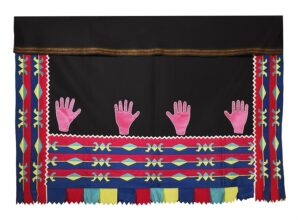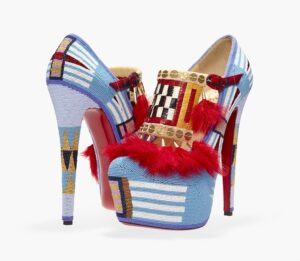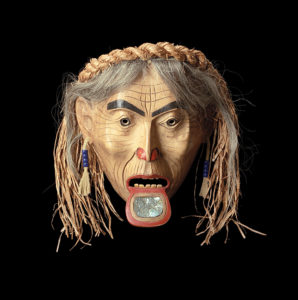By Cedar Marie (Standing Rock Sioux descent)

Hearts of Our People pays tribute to Indigenous women’s contributions to American and Canadian art. Themes of legacy, relationships, and power provide a cogent roadmap to navigate the bonds that exist between Native ancestral pasts and their influence on the present and future. Artists Mona M. Smith and Juanita Espinosa welcome viewers to the exhibition and to the Dakota lands that Mia is built upon. The images and sounds of the Mississippi River, birds in sunlit trees, and the quietude of the Milky Way (re)introduce viewers to the cyclical relationships that nature plays in creating and supporting all of life. Stories rooted within the 115 artworks from 50 US and Canadian tribes tell of memories, cultural practices, time and place, identity, and family, among additional narratives. Juxtapositions between different Native communities, artworks, materials, and processes are woven throughout the exhibition and offer a rich, though sometimes overwhelming, visual, and conceptual experience.
Rose B. Simpson’s customized 1985 black El Camino, Maria, is paired with a storage jar crafted by San Ildefonso Pueblo artist Maria Martinez (1887–1980). Drawing from both the history of place and the legacy of Martinez’s black-on-black painted pottery, the “muscle car” serves as a vessel of identity and power for Simpson as a Pueblo woman participating in contemporary art and car culture in the Southwest.
Indigenous knowledge is similarly embodied in the present in Cara Romero’s photographic collaboration with clay artist Kaa Folwell. Painted with clay in a zigzagging pattern, Folwell’s body becomes a vehicle-vessel for “personifying the spirit of Clay Lady,” a matriarchal figure in Pueblo creation stories, and transmitting ancestral Mesa Verde values through new designs.

Materials and patterns common in Indigenous artwork were and are integrated into unexpected commodities such as Jamie Okuma’s high heels in Adaption II, Chair with Quillwork Panels (by an unknown Mi’kmaw artist), and Valise, by Nellie Two Bear Gates, as a means to express and maintain Native identities. Beadwork is simulated in Christi Belcourt’s beautiful painting The Wisdom of the Universe, a piece honoring Canadian species listed as endangered or already extinct. As I explored the painting’s detailed patterns, points, and textures of color, I was reminded of the Alaska Native youths, and now youths from across the globe, whose forward-thinking activism is challenging the political moral compass on climate change. They are demanding, as we all must, that we take greater care of their future by decreasing our carbon footprint today.

Tanis S’eitin’s Hit and Julie Buffalohead’s The Garden provide a different yet equally potent wakeup call that we have not yet learned from or taken full responsibility for acts of institutional racism and war. And, in a simple yet stunning collision of meaning and materials, Dana Claxton’s Buffalo Bone China—consisting of black and white footage of stampeding buffalo projected onto a wall in front of a mound of broken china cups, plates, and saucers—is a painful reminder of how the US government forced Native populations onto reservations by hunting buffalo to near extinction. The buffalo bones were then processed into chinaware, according to the text posted with the installation.
In another room that I began to silently call the “honor room,” a patterned buffalo robe from 1892 serves as a legacy symbol for Indigenous power and reinforces the exhibition’s thematic pathways. Nearby, Zoë Urness’ photograph December 5, 2016: No Spiritual Surrender, illustrates the resiliency of veterans on a frigid, sub-zero winter day during pipeline protests at Standing Rock Reservation. As a daughter of a mother who is/was an enrolled member of Standing Rock, this artwork hit pretty close to home.

Shan Goshorn’s (1957–2018) Hearts of Our Women also honors more than 700 Native women in a series of small woven baskets with embedded photographs and names. Juxtaposed with nearby cradleboards, reclamation, transformation, and power are shifting in that honor room, passing intertribal knowledge, values, and the strength of generations of Native women right before the viewer’s eyes.
The exhibition comes full circle with Marianne Nicolson’s Bax’wana’tsi: The Container for Souls. Etched Kwakwaka’wakw symbology and photographs inside of a glass vitrine are projected onto the walls of the room through a small yet brilliant inner light, allowing the viewer to enter into, what feels like to me, a sacred space—embodied, yet ephemeral and shadowed, delicate and sovereign. Exiting the exhibition through Nicolson’s “cultural container,” body and soul become one with the opportunity to enter into the stream again renewed, yet changed. I am transported back to the beginning, to the Dakota lands that Mia is built upon, to the sounds of the Mississippi River, birds in sunlit trees, and the quietude of the Milky Way, and with the legacies, relationships, and power of Hearts of our People to guide me.

Exhibition Dates
- Minneapolis Institute of Art (Mia), June 2 – August 18, 2019
- Frist Museum of Art, Nashville, TN, September 27, 2019 – January 12, 2020
- Smithsonian American Art Museum, Renwick Gallery, Washington, DC, February 21, 2020 – May 17, 2020
- Philbrook Museum of Art, Tulsa, OK, June 28, 2020 – September 20, 2020
Links
- The catalogue is available for sale online.
- Hearts of Our People: The Legacy, Relationships & Power of Native Women Artists symposium video: part one | part two | part three
